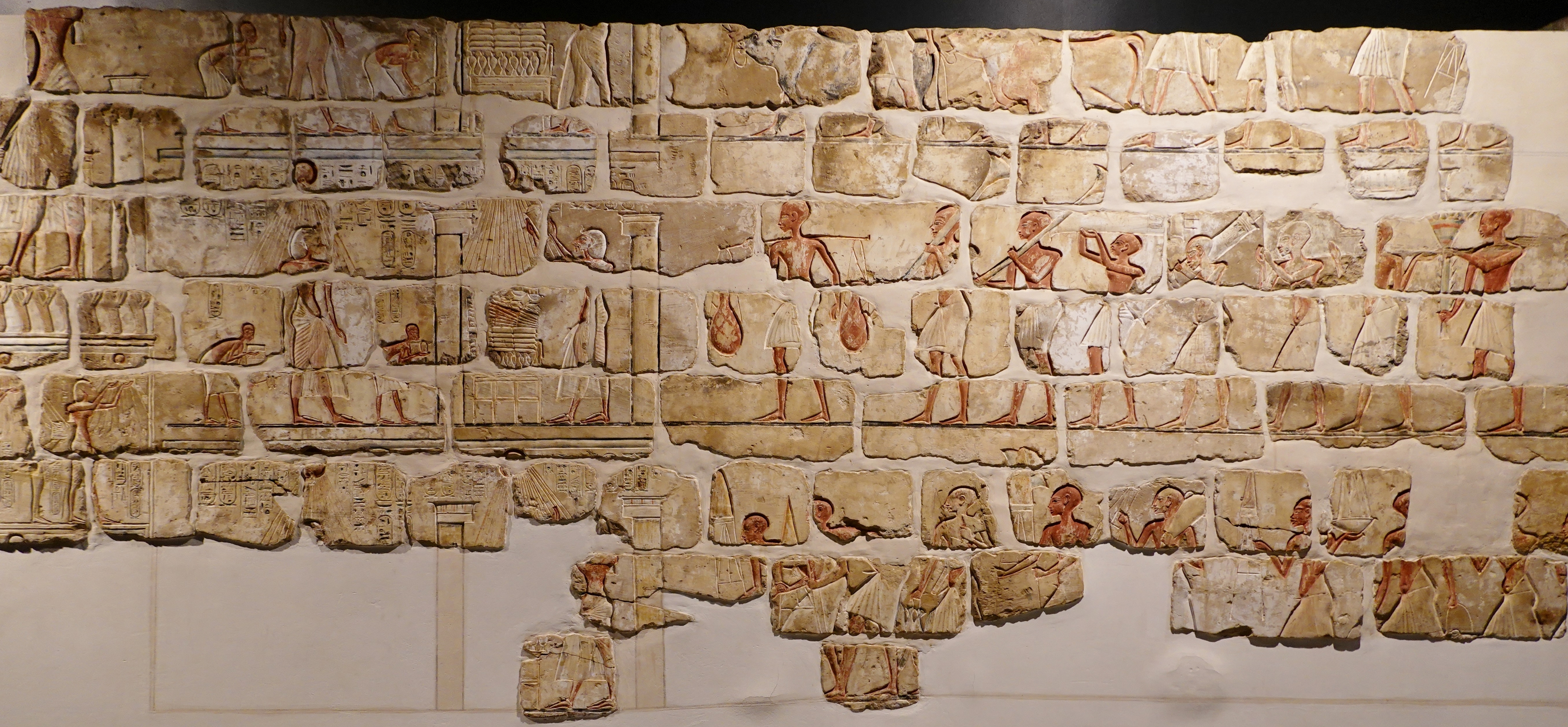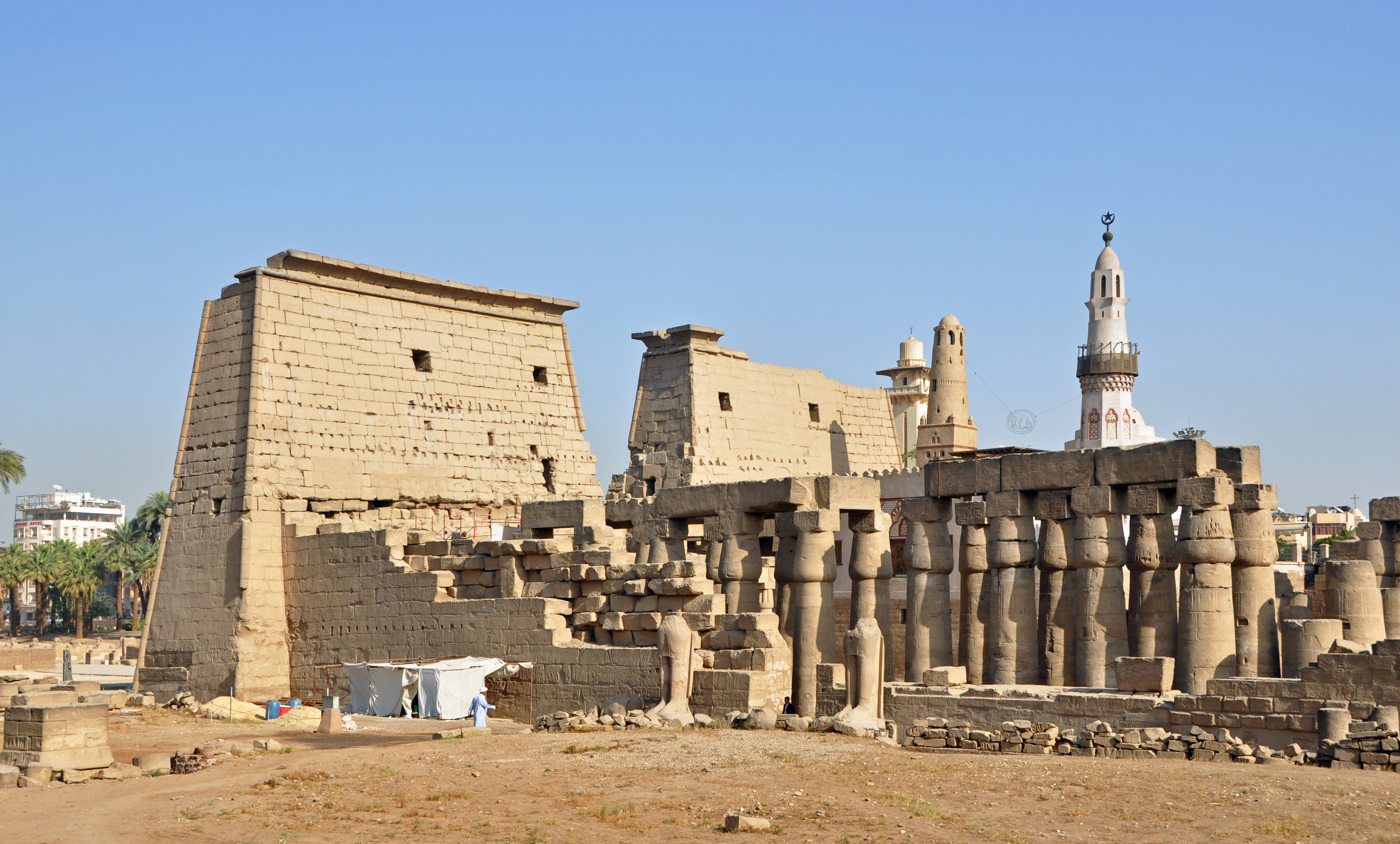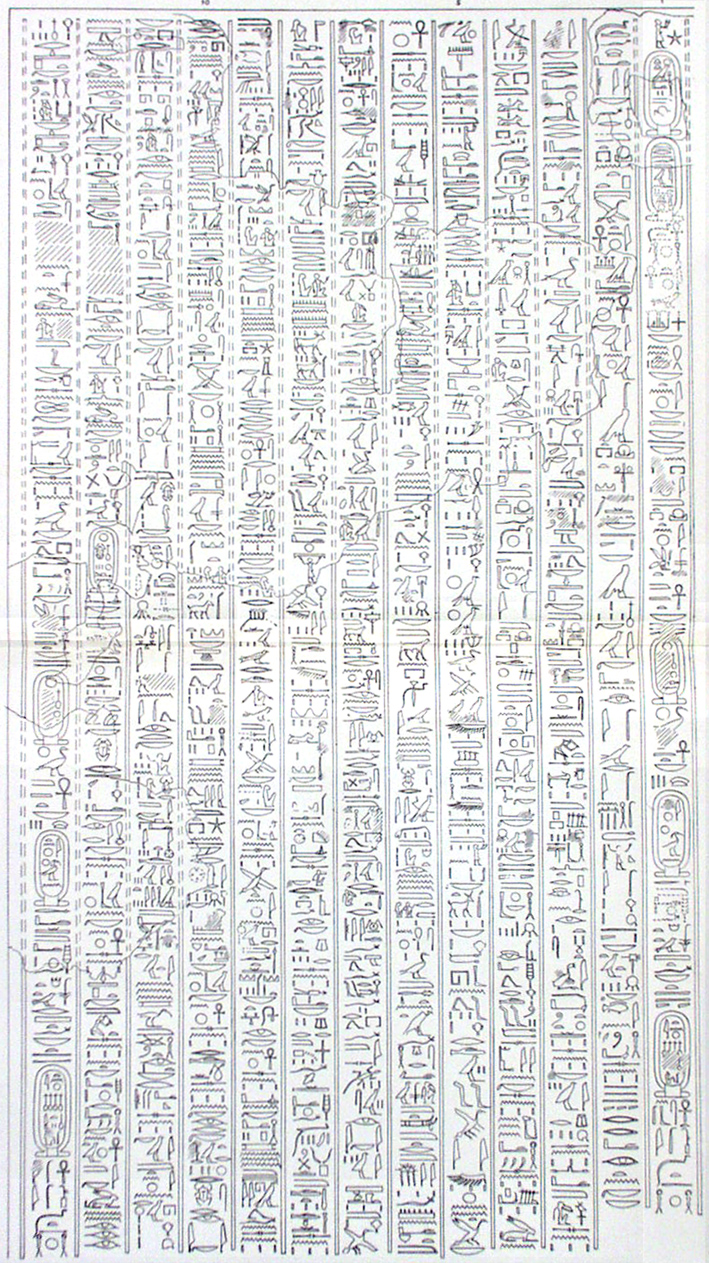|
Talatat
Talatat are limestone blocks of standardized size (c. 27 by 27 by 54 cm, corresponding to by by 1 ancient arm, cubit symbol (hieroglyph), Egyptian cubits) used during the Eighteenth Dynasty of Egypt, 18th Dynasty reign of the Pharaoh Akhenaten in the building of the Aten temples at Karnak and Akhetaten (modern Amarna). The standardized size and their small weight made construction more efficient. Their use may have begun in the second year of Akhenaten's reign. After the Amarna Period talatat construction was abandoned, apparently not having withstood the test of time. The minority of blocks intended for a visible surface are often decorated in a variety of techniques to make up large scenes covering several blocks. Sunk relief, engraving paint, and sometimes added plaster are used, often in combination. Amenhotep IV talatats The blocks used in the Temple of Amenhotep IV in Karnak, and the other abandoned temples devoted to the deity Aten, were reused by Horemheb and Ram ... [...More Info...] [...Related Items...] OR: [Wikipedia] [Google] [Baidu] |
Akhenaten
Akhenaten (pronounced ), also spelled Akhenaton or Echnaton ( ''ʾŪḫə-nə-yātəy'', , meaning 'Effective for the Aten'), was an ancient Egyptian pharaoh reigning or 1351–1334 BC, the tenth ruler of the Eighteenth Dynasty of Egypt, Eighteenth Dynasty. Before the fifth year of his reign, he was known as Amenhotep IV (, meaning "Amun is satisfied", Hellenized as ''Amenophis IV''). As a pharaoh, Akhenaten is noted for abandoning traditional ancient Egyptian religion of polytheism and introducing Atenism, or worship centered around Aten. The views of Egyptologists differ as to whether the religious policy was absolutely monotheism, monotheistic, or whether it was monolatristic, religious syncretism, syncretistic, or henotheistic. This culture shift away from traditional religion was reversed after his death. Akhenaten's monuments were dismantled and hidden, his statues were destroyed, and his name Damnatio memoriae, excluded from regnal list, lists of rulers compiled by lat ... [...More Info...] [...Related Items...] OR: [Wikipedia] [Google] [Baidu] |
Temple Of Amenhotep IV
The Temple of Amenhotep IV was an ancient monument at Karnak in Luxor, Egypt. The structures were used during the New Kingdom, in the first four years of the 18th Dynasty reign of the Egyptian Pharaoh Akhenaten, when he still used the name Amenhotep IV. The edifices may have been constructed at the end of the reign of his father, Amenhotep III, and completed by Akhenaten. Location and layout The temple was constructed outside the boundaries of the Precinct of Amon-Re, to its east. The main temple in the complex was named ''Gm–p3–itn'' (Gem-pa-Aten), which means "The Sun Disc is Found in the Estate of the God Aten". The other monuments were named ''Hwt–bnbn'' (Hwt benben / "The Mansion of the Benben stone"), ''Rwd–mnw–n–itn–r–nḥḥ'' (Rud-menu / "Sturdy are the Monuments of the Sun Disc Forever"), and ''Tni–mnw–n–itn–r–nḥḥ'' (Teni–menu / "Exalted are the Monuments of the Sun Disc Forever"). Ve ... [...More Info...] [...Related Items...] OR: [Wikipedia] [Google] [Baidu] |
Precinct Of Amon-Re
The Precinct of Amun-Re, located near Luxor, Egypt, is one of the four main Egyptian temple, temple enclosures that make up the immense Karnak, Karnak Temple Complex. The precinct is by far the largest of these and the only one that is open to the general public. The temple complex is dedicated to the principal god of the Theban Triad, Amun, in the form of Amun-Re. The site occupies some 250,000 m2 and contains many structures and monuments. The main temple itself, the Temple of Amun, covers some 61 acres. Some parts of the complex are closed or semi-closed, including large parts of the North-South Axis (the 8th, 9th, and 10th Pylon (architecture), pylons), which are under active excavation or restoration. The whole southeast corner is semi-closed. The northwest corner is a museum that requires an additional ticket to visit. Most of the southwest is an open-air assembling area containing millions of stone fragments, from small to huge, laid out in long rows, awaiting reassembly ... [...More Info...] [...Related Items...] OR: [Wikipedia] [Google] [Baidu] |
Horemheb
Horemheb, also spelled Horemhab, Haremheb or Haremhab (, meaning "Horus is in Jubilation"), was the last pharaoh of the Eighteenth Dynasty of Egypt, 18th Dynasty of Egypt (1550–1292 BC). He ruled for at least 14 years between 1319 BC and 1292 BC. He had no relation to the preceding royal family other than by marriage to Mutnedjmet, who is thought (though disputed) to have been the daughter of his predecessor, Ay (pharaoh), Ay; he is believed to have been of common birth. Before he became pharaoh Horemheb was the commander-in-chief of the Military of ancient Egypt, army under the reigns of Tutankhamun and Ay (pharaoh), Ay. After his accession to the throne, he reformed the Egyptian state and it was during his reign that official action against the preceding Amarna rulers began, which is why he is considered the ruler who restabilized his country after the troublesome and divisive Amarna Period. Horemheb demolished monuments of Akhenaten, reusing the rubble in ... [...More Info...] [...Related Items...] OR: [Wikipedia] [Google] [Baidu] |
Luxor Museum Relief Talatat 06
Luxor is a city in Upper Egypt. Luxor had a population of 263,109 in 2020, with an area of approximately and is the capital of the Luxor Governorate. It is among the oldest continuously inhabited cities in the world. Luxor has frequently been characterized as the ''world's greatest open-air museum'', as the ruins of the Egyptian temple complexes at Karnak and Luxor stand within the modern city. Immediately opposite, across the River Nile, lie the monuments, temples and tombs of the West Bank Theban Necropolis, which includes the Valley of the Kings and the Valley of the Queens. Thousands of tourists from all around the world arrive annually to visit Luxor's monuments, contributing greatly to the economy of the modern city. Yusuf Abu al-Haggag is the prominent Muslim historical figure of Luxor. Etymology The name ''Luxor'' derives from the Arabic , meaning "castle" or "palace", in the plural form ''al-quṣūr'' (“the palaces"). It may be equivalent to the Greek and Copti ... [...More Info...] [...Related Items...] OR: [Wikipedia] [Google] [Baidu] |
Egyptian Arabic
Egyptian Arabic, locally known as Colloquial Egyptian, or simply as Masri, is the most widely spoken vernacular Arabic variety in Egypt. It is part of the Afro-Asiatic language family, and originated in the Nile Delta in Lower Egypt. The estimated 111 million Egyptians speak a continuum of dialects, among which Cairene is the most prominent. It is also understood across most of the Arabic-speaking countries due to broad Egyptian influence in the region, including through Egyptian cinema and Egyptian music. These factors help make it the most widely spoken and by far the most widely studied variety of Arabic. While it is primarily a spoken language, the written form is used in novels, plays and poems (vernacular literature), as well as in comics, advertising, some newspapers and transcriptions of popular songs. In most other written media and in radio and television news reporting, literary Arabic is used. Literary Arabic is a standardized language based on the langu ... [...More Info...] [...Related Items...] OR: [Wikipedia] [Google] [Baidu] |
Pylon (architecture)
A pylon is a monumental gate of an Egyptian temple (Egyptian: ''bxn.t'' in the Manuel de Codage transliterationErmann & Grapow, ''Wörterbuch der ägyptischen Sprache'', vol.1, 471.9–11). The word comes from the Greek term 'gate'. It consists of two pyramidal towers, each tapered and surmounted by a cornice, joined by a less elevated section enclosing the entrance between them.Toby Wilkinson, ''The Thames and Hudson Dictionary of Ancient Egypt'', Thames & Hudson, 2005. p.195 The gate was generally about half the height of the towers. Contemporary paintings of pylons show them with long poles flying banners. Egyptian architecture In ancient Egyptian religion, the pylon mirrored the hieroglyph ''akhet'' 'horizon', which was a depiction of two hills "between which the sun rose and set". Consequently, it played a critical role in the symbolic architecture of a building associated with the place of re-creation and rebirth. Pylons were often decorated with scenes emphasizing ... [...More Info...] [...Related Items...] OR: [Wikipedia] [Google] [Baidu] |
Ramesses II
Ramesses II (sometimes written Ramses or Rameses) (; , , ; ), commonly known as Ramesses the Great, was an Pharaoh, Egyptian pharaoh. He was the third ruler of the Nineteenth Dynasty of Egypt, Nineteenth Dynasty. Along with Thutmose III of the Eighteenth Dynasty of Egypt, Eighteenth Dynasty, he is often regarded as the greatest, most celebrated, and most powerful pharaoh of the New Kingdom of Egypt, New Kingdom, which itself was the most powerful period of ancient Egypt. He is also widely considered one of ancient Egypt's most successful warrior pharaohs, conducting no fewer than 15 military campaigns, all resulting in victories, excluding the Battle of Kadesh, generally considered a stalemate. In Ancient Greek literature, ancient Greek sources, he is called Ozymandias, derived from the first part of his Egyptian-language regnal name: . Ramesses was also referred to as the "Great Ancestor" by successor pharaohs and the Egyptian people. For the early part of his reign, he focu ... [...More Info...] [...Related Items...] OR: [Wikipedia] [Google] [Baidu] |
Aten
Aten, also Aton, Atonu, or Itn (, reconstructed ) was the focus of Atenism, the religious system formally established in ancient Egypt by the late Eighteenth Dynasty pharaoh Akhenaten. Exact dating for the Eighteenth Dynasty is contested, though a general date range places the dynasty in the years 1550 to 1292 BCE. The worship of Aten and the coinciding rule of Akhenaten are major identifying characteristics of a period within the Eighteenth Dynasty referred to as the Amarna Period (1336 BCE). Atenism and the worship of the Aten as the sole god of ancient Egypt state worship did not persist beyond Akhenaten's death. Not long after his death, one of Akhenaten's Eighteenth Dynasty successors, Tutankhamun, reopened the state temples to other Egyptian gods and re-positioned Amun as the pre-eminent solar deity. Aten is depicted as a solar disc emitting rays terminating in human hands. Etymology The word ''Aten'' appears in the Old Kingdom as a noun meaning "disc" w ... [...More Info...] [...Related Items...] OR: [Wikipedia] [Google] [Baidu] |
Sunk Relief
Shipwrecking is any event causing a ship to wreck, such as a ship collision, collision causing the ship to sink; the stranding of a ship on rocks, land or shoal; poor maintenance, resulting in a lack of seaworthiness; or the destruction of a ship either intentionally or by violent weather. The resulting physical remains of a wrecked ship are called ''shipwreck''. Causes Factors for the loss of a ship may include: * poor naval architecture, design or failure of the ship's equipment or hull (watercraft), hull - submarine hull, pressure hull * instability, due to poor design, improperly stowed cargo, cargo that shifts its position or the free surface effect * navigation errors and other human errors, leading to collisions (with another ship, rocks, an iceberg (), etc.) or Ship grounding, running aground (''Costa Concordia'') * bad weather and powerful or large waves or gale winds: This often leads to a vessel being swamped by waves, holed on rocks or a reef, or shipwrecking#Cau ... [...More Info...] [...Related Items...] OR: [Wikipedia] [Google] [Baidu] |
Relief Depicting The Purification Of Queen Kiya (?) MET DP120058
Relief is a sculptural method in which the sculpted pieces remain attached to a solid background of the same material. The term ''relief'' is from the Latin verb , to raise (). To create a sculpture in relief is to give the impression that the sculpted material has been raised above the background plane. When a relief is carved into a flat surface of stone (relief sculpture) or wood (relief carving), the field is actually lowered, leaving the unsculpted areas seeming higher. The approach requires chiselling away of the background, which can be time-intensive. On the other hand, a relief saves forming the rear of a subject, and is less fragile and more securely fixed than a sculpture in the round, especially one of a standing figure where the ankles are a potential weak point, particularly in stone. In other materials such as metal, clay, plaster stucco, ceramics or papier-mâché the form can be simply added to or raised up from the background. Monumental bronze reliefs are ma ... [...More Info...] [...Related Items...] OR: [Wikipedia] [Google] [Baidu] |
Limestone
Limestone is a type of carbonate rock, carbonate sedimentary rock which is the main source of the material Lime (material), lime. It is composed mostly of the minerals calcite and aragonite, which are different Polymorphism (materials science), crystal forms of calcium carbonate . Limestone forms when these minerals Precipitation (chemistry), precipitate out of water containing dissolved calcium. This can take place through both biological and nonbiological processes, though biological processes, such as the accumulation of corals and shells in the sea, have likely been more important for the last 540 million years. Limestone often contains fossils which provide scientists with information on ancient environments and on the evolution of life. About 20% to 25% of sedimentary rock is carbonate rock, and most of this is limestone. The remaining carbonate rock is mostly Dolomite (rock), dolomite, a closely related rock, which contains a high percentage of the mineral Dolomite (mine ... [...More Info...] [...Related Items...] OR: [Wikipedia] [Google] [Baidu] |







